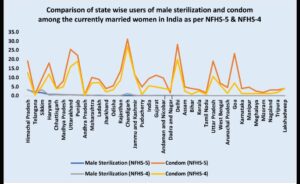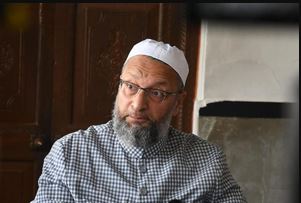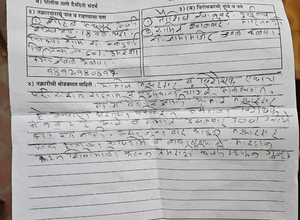
“Male participation in improving the reproductive health of couples is crucial. Expert says government’s effort to increase male participation in family planning through observation of programme like ‘Vasectomy Fortnight’ need to expand its scope, nature and nomenclature. Time has reached to change the name rather to Men Engagement Fortnight”.
Bhubaneswar: The government on 24th November released the factsheets of key indicators on population, reproductive and child health, family welfare, nutrition and others for India as well as 14 states and UTs, clubbed under phase two, of the 2019-21 NFHS-5. The findings of phase one of the NFHS-5 for 22 states and UTs were released in December, 2020.
As per the findings of the report there has been improvements in family planning indicators such as Total Fertility Rate (TFR), modern contraceptive prevalence rate (mCPR) and unmet need for family Planning from 2015-16, NFHS-4. However, it is surprising to note that partner of only 3 per 1000 currently married age group (15-49 years) are using male sterilization (Vasectomy) as a modern contraceptive method. There is no change in current use of male sterilization between NFHS-4 and NFHS-5 at all India level (0.3%). But there is an increase of 3.9% in use of condom during NFHS-4 (5.6%) and NFHS-5 (9.5%) indicating choice of family planning methods for male has been shifted from permanent methods (conventional vasectomy and non-scalpel vasectomy) to spacing methods (condom) among the young couples.
At the state level there are 14 states/UTs which showed increase in male sterilization users from NFHS-4 to NFHS-5 namely. Andaman and Nicobar Islands, Bihar, Chhattisgarh, Dadra and Nagar Haveli and Daman and Diu, Gujarat, Haryana, Jharkhand, Ladakh, Madhya Pradesh, Odisha, Puducherry, Rajasthan, Tamil Nadu and Telangana.
The increase in use of condoms among the couples has been a pan India feature as most of the states/UTs except 7 including Andhra Pradesh, Chandigarh, Himachal Pradesh, Jammu and Kashmir, Manipur, Punjab and Sikkim have shown a decreasing trend in condom users from NFHS-4 to NFHS-5.
The improvement in condom users and no change in male sterilization acceptors at the state and national level between NFHS-4 and NFHS-5 has shown sub optimal level of male involvement in family planning programmes in India. While the permanent methods of contraception have traditionally found more acceptance in India, the maximum number of acceptors are women. Hence male participation in improving the reproductive health of couples is crucial. Besides, in order to achieve the Sustainable Development Goals (SDGs), including reducing maternal mortality, the participation of men in reproductive health issues, including family planning, is essential. The failure in involving men in family planning activity will continue women bearing uneven burden of terminal methods family planning and sterilization.

Since 2016, the Ministry of Health and Family Welfare is observing ‘Vasectomy Fortnight’, an initiative to raise awareness about male sterilisation and encourage men to participate in the process of family planning. Every year From November 21 to December 4, all States and Union Territories are expected to observe the ‘Vasectomy Fortnight’. During this period, respective administrations are expected to provide quality male sterilisation services at public health centres. To promote male sterilization the government is providing Rs. 2000/- to the male sterilization acceptors and incentives to the service providers. The programme has basically two component including demand generation and service provisioning for male sterilization during the fortnight. The recent NFHS-5 data however, indicates only awareness on FP methods may not trigger the behavioural change leading to acceptance of family planning methods among men. There is a need for constructive and continuous engagement with men. Constructively engaging men often focuses on three specific potential areas for male involvement: men as clients, men as supportive partners and men as agents of change.
In order to ensure increased participation of men in family planning and reproductive health;
- The observation of vasectomy fortnight should not be one time activity rather be a yearlong activity culminating in fortnight observation recognizing the efforts made by users, providers, frontline workers and volunteers.
- It should promote informed choice by providing full range of information on family planning methods including advantages and disadvantages rather than single focus on male sterilization.
- The name vasectomy fortnight connotes men’s role limited to client only. Changing the name of the programme to men engagement fortnight (suggestive) may expand the role of male as supportive partner and change agent as well.
By: Dr. Manmath K. Mohanty
The author is a reproductive health expert currently working in CMSD-a national level leading research and consulting agency and has served UNFPA for quite sometime to promote family planning programmes in the state of Odisha.






